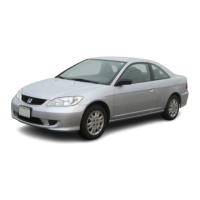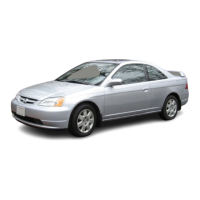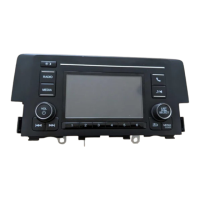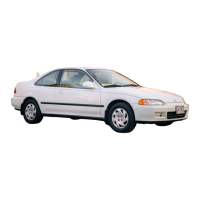
Do you have a question about the Honda Civic Coupe 2004 and is the answer not in the manual?
| Brand | Honda |
|---|---|
| Model | Civic Coupe 2004 |
| Category | Automobile |
| Language | English |
Provides an overview of the owner's manual and its purpose.
Highlights the importance of vehicle safety and safe operating practices.
Information on protecting occupants with seat belts, airbags, and child restraints.
Explains the various warning lights and indicators on the instrument panel.
Details on the odometer, fuel gauge, temperature gauge, and other essential gauges.
Location and operation of controls on the steering wheel and surrounding dashboard.
Information on using master keys, valet keys, remote transmitters, and locks.
Instructions for adjusting manual and power seats, including lumbar support and headrests.
Details on features like glove box, beverage holders, console compartment, and lighting.
Covers operation of climate control, fan, A/C, defrost, and recirculation modes.
Instructions for tuning, selecting stations, using presets, and adjusting sound settings.
Guide to operating the XM Satellite Radio, including channel selection and features.
Instructions for loading, playing, and managing CDs, including error messages.
Information on operating the cassette tape player, including functions and care.
Details on using steering wheel buttons for audio system, cruise control, and other functions.
Procedure for setting the vehicle's clock, including automatic and manual adjustments.
Instructions on activating, changing speed, canceling, and resuming cruise control.
Guide to programming the HomeLink system to operate garage doors and other devices.
Recommendations for the first 600 miles to ensure vehicle reliability and performance.
Information on recommended gasoline octane rating and fuel additives.
Steps for refueling, checking fluids, and opening the hood at a service station.
Tips on how to improve fuel efficiency through driving habits and maintenance.
Guidance on installing accessories and potential impacts on vehicle safety and performance.
Information on storage areas, load limits, and safe cargo distribution.
Checklist of essential inspections and adjustments before operating the vehicle.
Instructions for starting the engine under normal and cold weather conditions.
Details on shifting gears, recommended shift points, and lockout features.
Information on shift lever positions, indicators, and operation of the automatic transmission.
Guidelines for safely parking the vehicle, including using the parking brake and wheel orientation.
Explanation of brake design, wear indicators, and checks for proper function.
How ABS works, activation, indicators, and safety reminders for its use.
Explanation of TCS operation, indicators, and recommendations for winter driving.
Guidance on load limits, towing equipment, trailer brakes, lights, and safe towing practices.
Essential safety precautions and warnings for performing vehicle maintenance tasks.
Information on normal and severe driving schedules, and when to service your vehicle.
Diagrams showing the location of all essential fluids for checking and refilling.
Instructions on checking and adding engine oil, including recommended oil type and capacity.
Step-by-step guide for changing the engine oil and oil filter, including required tools.
Instructions for checking and adding engine coolant, including warnings and precautions.
Procedures for checking and refilling automatic and manual transmission fluid.
Guidance on checking and replacing brake and clutch fluid levels and types.
Instructions for replacing headlight bulbs and other exterior and interior lights.
Information on tire inflation, inspection, rotation, replacement, and winter driving.
Steps for checking battery condition, terminals, and performing basic maintenance.
Preparation steps for parking the vehicle for extended periods.
Information on using the compact spare tire, precautions, and replacement.
Detailed steps for safely changing a flat tire, including tool usage and safety warnings.
Diagnosing and addressing common causes for an engine failing to start.
Step-by-step instructions and safety precautions for jump starting a vehicle's battery.
What to do if the engine overheats, including immediate actions and coolant checks.
Explanation of the low oil pressure indicator and immediate actions to take.
Information on charging system and malfunction indicators and their meaning.
Meaning of the brake system indicator and actions to take if it appears.
Guidance on professional towing equipment and procedures for safe vehicle transport.
Steps to manually close the moonroof if the electric motor fails.
Instructions for checking and replacing fuses in the interior and under-hood fuse boxes.
Diagrams and charts showing the location and function of vehicle fuses.
Locations of Vehicle Identification Number (VIN), engine, and transmission numbers.
Dimensions, weights, capacities, engine, and tire specifications for 4-cylinder models.
Dimensions, weights, capacities, engine, and tire specifications for 6-cylinder models.
Explanation of tire grades for treadwear, traction, and temperature ratings.
Information on gasoline blends with alcohol or ether compounds and their usage.
Overview of engine emissions control systems and their function.
Description of the catalytic converter's function, maintenance, and precautions.
Guidance on passing state emissions tests, including readiness codes and driving conditions.
Contact information for Honda dealerships, customer service, and required details for inquiries.
Summary of new vehicle, emissions, battery, muffler, and parts warranties for U.S. and Canadian owners.
How to inform NHTSA and American Honda about potential vehicle safety defects.
Information on how to purchase factory authorized service and owner's manuals.












